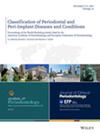Healing following ridge preservation using demineralized allograft particles or fibers alone, and combined with xenograft.
IF 3.8
2区 医学
Q1 DENTISTRY, ORAL SURGERY & MEDICINE
引用次数: 0
Abstract
BACKGROUND Allografts and xenografts are viable options for alveolar ridge preservation. This study evaluated histologic wound healing when using demineralized freeze-dried bone allograft (DFDBA) alone, in fiber or particulate form, and in combination with xenograft. Alveolar dimensional changes were also evaluated. METHODS This four-arm, parallel, randomized controlled trial included 120 patients with a nonmolar tooth receiving extraction and ridge preservation who were blindly randomized into one of four groups: DFDBA particulate alone (DCP), DFDBA fibers alone (DCF), xenograft combined with DCP (DPX), and xenograft combined with DCF (DFX). After 18-20 weeks of healing, bone cores were collected for histologic analysis of vital bone, residual allograft, residual xenograft, and connective tissue. Ridge dimensional changes were evaluated with standardized measuring stents. RESULTS There was no difference in mean vital bone formation between DCP (37.33%) and DCF (40.76%) or between DPX (24.46%) or DFX (23.85%), but more vital bone was present when DFDBA in either form was used alone (DCF, DCP) compared to combining with xenograft (DFX, DPX). Significantly less residual allograft was found in DCF (3.57%) compared to DCP (16.5%). Similarly, when combined with xenograft, there was less residual allograft with DFDBA fibers (DFX = 2.19%) than with particles (DPX = 9.88%). No significant differences in alveolar ridge dimensional change were noted between the groups. CONCLUSION DFDBA fibers resulted in less residual allograft compared to DFDBA particulate. Allograft-alone groups had more vital bone than groups with xenograft, but there was no difference between fiber allograft and particulate allograft alone. CLINICAL TRIAL NUMBER Clinicaltrials.gov NCT05400213 PLAIN LANGUAGE SUMMARY: Placing a bone graft in the socket after tooth extraction can decrease bone loss during healing in preparation for a dental implant. This study collected histologic wound healing data on human bone graft materials in a fiber and particle form alone and in combination with a cow-derived (bovine) bone graft material. One hundred twenty patients who needed a tooth extracted enrolled in the study, and one of the four bone graft materials was placed in the site. After 18-20 weeks of healing, patients returned for placement of a dental implant. At this time, a bone sample was collected for microscopic examination. Measurements of the bone dimensions at the site were also done. The fiber bone graft material resorbed more rapidly relative to the particulate form, but there was no difference in new bone formed between the fibers and particles. The human bone grafts in either fiber or particle form used alone also formed more new bone than when they were mixed with the bovine bone graft. Clinically, the bone dimensions did not show significant differences between the four groups.单独使用脱矿化同种异体移植物颗粒或纤维并结合异种移植物保存脊骨后的愈合。
背景:同种异体移植物和异种移植物是保存牙槽嵴的可行选择。本研究评估了脱矿冻干同种异体骨移植物(DFDBA)单独使用、纤维或颗粒形式以及与异种移植物联合使用时的组织学伤口愈合情况。还评估了肺泡尺寸的变化。方法采用四臂、平行、随机对照试验,将120例接受拔牙和牙脊保存的非磨牙患者随机分为四组:DFDBA颗粒单独组(DCP)、DFDBA纤维单独组(DCF)、异种移植物联合DCP组(DPX)和异种移植物联合DCF组(DFX)。愈合18-20周后,收集骨芯进行活体骨、残余同种异体移植物、残余异种移植物和结缔组织的组织学分析。用标准化测量支架评估脊的尺寸变化。结果DCP(37.33%)与DCF(40.76%)、DPX(24.46%)与DFX(23.85%)的成骨率无显著差异,但单独使用DFDBA (DCF、DCP)的成骨率高于与异种移植(DFX、DPX)的成骨率。与DCP(16.5%)相比,DCF(3.57%)残留同种异体移植物明显减少。同样,当与异种移植物联合时,DFDBA纤维(DFX = 2.19%)比颗粒(DPX = 9.88%)的同种异体移植物残留更少。两组间牙槽嵴尺寸变化无明显差异。结论与DFDBA颗粒相比,DFDBA纤维可减少同种异体移植物的残留。同种异体单独移植组比异种移植组有更多的活骨,但纤维同种异体移植与颗粒同种异体单独移植之间没有差异。摘要:拔牙后在牙槽内植入植骨可以减少植牙愈合过程中的骨质流失。本研究收集了单独的纤维和颗粒形式的人骨移植材料以及与牛源(牛)骨移植材料联合使用的组织学伤口愈合数据。120名需要拔牙的患者参加了这项研究,四种骨移植材料中的一种被放置在该部位。18-20周愈合后,患者返回种植牙。此时,采集骨样本进行显微镜检查。还测量了该地点的骨骼尺寸。纤维骨移植材料相对于颗粒形式的骨吸收更快,但纤维和颗粒之间的新骨形成没有差异。单独使用的纤维或颗粒形式的人骨移植物也比与牛骨移植物混合时形成更多的新骨。临床上,四组间骨尺寸无明显差异。
本文章由计算机程序翻译,如有差异,请以英文原文为准。
求助全文
约1分钟内获得全文
求助全文
来源期刊

Journal of periodontology
医学-牙科与口腔外科
CiteScore
9.10
自引率
7.00%
发文量
290
审稿时长
3-8 weeks
期刊介绍:
The Journal of Periodontology publishes articles relevant to the science and practice of periodontics and related areas.
 求助内容:
求助内容: 应助结果提醒方式:
应助结果提醒方式:


